IEEE802.11p ahead of
LTE-V2V for safety applications
Alessio Filippi, Kees Moerman, Vincent Martinez and Andrew Turley – NXP Semiconductors.
Onn Haran and Ron Toledano – Autotalks.
Executive Summary
Car-to-car communication is attracting significant attention as it promises to drastically reduce road fatalities, im-
prove mobility and enable a high-level of vehicle automation. Supporting safety critical applications is at the core
of car-to-car communication, and for years, the technology of choice for V2X has been IEEE802.11p. Recently,
a new standard addressing V2X applications has started evolving under the umbrella of 3GPP, whose focus is
mobile broadband standardization. Because the safety of millions of road users will depend on the performance
of these technologies, it is important to compare them.
�
There are several relevant facts important to highlight when comparing IEEE802.11p to LTE-V2X:
• IEEE802.11p is ready now, LTE-V2X is not [4]. Today, IEEE802.11p-based products are available on the market
from multiple silicon vendors. Some Tier1s have complete solutions available. In contrast, there is no LTE-V2X
product available in the market today, and it will most likely take several years before a complete solution will be
ready and tested. The promised 5G version of V2X will have an even longer time horizon;
• IEEE802.11p is already installed in cars on the road. An end-user can buy a vehicle (e.g. GM Cadillac1 ) equipped
with IEEE802.11p technology today;
• The V2V NPRM has been published [1]. It clearly indicates that the US Government apparently has the intention
to deploy IEEE802.11p as a technology thoroughly tested, validated and available for safety critical applications;
• IEEE802.11p mass deployment could begin soon. Volkswagen, one of the largest car manufacturers worldwide,
publicly announced that from 2019 onwards, they will equip their first model series with IEEE802.11p technology2.
The cellular community is advocating that V2X implementations should wait for cellular technology to be ready and
tested, and disregard the investments and field tests done to validate IEEE802.11p for safety critical applications.
More concretely, the cellular community claims that LTE-V2X offers:
• a strong cellular eco-system which leverages years of experience in providing paid-services and a mature techno-
logy available worldwide. This is a valid argument, but it refers to entertainment services in a cellular-based
technology. The communication between a device and a base-station is fundamentally different from the device-
to-device communication in a dynamic environment;
• twofold better performance [6]. However, it is IEEE802.11p which outperforms LTE-V2X in important V2V use
cases as we show in this article;
• minor added cost. This is questionable as the support of safety critical applications strongly indicates the need to
separate those from the entertainment SW and HW. Therefore, LTE-V2X will likely be physically separated from
the cellular modem;
1
2
http://media.cadillac.com/media/us/en/cadillac/news.detail.html/content/Pages/news/us/en/2017/mar/0309-v2v.html
https://www.volkswagen-media-services.com/en/detailpage/-/detail/With-the-aim-of-increasing-safety-in-road-traffic-Volkswagen-will-
enable-vehicles-to-communicate-with-each-other-as-from-2019/view/5234247/6e1e015af7bda8f2a4b42b43d2dcc9b5?p_p_
auth=oyU0Lqiz
2
�
• a roadmap of evolution and future proof technology due to the continuous effort in improving the technology
via the well-tested mechanism of the 3GPP meetings. While this might be true, introducing an updated standard
every 12 to 15 months does not guarantee that older vehicles will be able to communicate with newer ones. This
is in contrast with the need of creating a stable and universal international standard to enable the success of V2X
technology.
The proposed LTE-V2X technology is a derivative of the cellular uplink technology that maintains similarity with the
current LTE systems: frame structure, sub-carrier spacing, clock accuracy requirements and the concept of a resource
block, to mention a few. These properties were not made to fit the vehicular use cases, but rather are inherited from
existing cellular technology. Consequently, LTE-V2X struggles to meet the specific application requirements of car-
to-car communications.
Technically, LTE-V2X suffers when there is no network to support the communications. It has stringent synchronizati-
on requirements (section 2.1), it cannot properly receive messages from nearby and closed-by transmitters (section
2.3) and it’s limited in its maximum range (section 2.4). Furthermore, it proposes a resource allocation scheme that
does not properly handle messages with variable size (section 2.5) and a multiple user access mechanism that is not
well suited for broadcasting messages (section 2.6) or for handling collisions of messages (section 2.9). The heavy-
weight design of LTE-V2X translates into a higher overhead (sections 2.7 and 2.8).
Commercially, LTE-V2X cannot leverage the presence of the standard LTE modem in the car. Different safety require-
ments (section 2.10) and technology needs (section 4.1) strongly suggest that the safety critical domain of LTE-V2X
will be separated from the entertainment domain of the standard LTE modem. The stringent synchronization require-
ments (section 3.2) could significantly increase the costs in the LTE-V2X hardware.
Strategically, LTE-V2X might not be the best technology for safety critical applications as its fast development cycle
does not match the automotive development cycle (section 4.1). The 3GPP community has already started working
on a new version of LTE-V2X while the current version has not been tested in the field yet. The next generation of
IEEE802.11p is also being considered (section 4.2.1) to capitalize on the experience of multiple large-scale field
trials to test safety critical applications.
Our conclusion is that IEEE802.11p technology is ideal for safety critical applications that must be supported in ab-
sence of a network. If the cellular infrastructure is available, LTE-V2X is a valid alternative and offers a more mature
eco-system for entertainment services. The win-win situation would be to focus on the strongest points of each tech-
nology and work together to provide the best car-to-car communication solution, continue deploying IEEE802.11p
for safety critical applications and ensure that the upcoming LTE-V2X technology can coexist.
3
�
1 Introduction
Since its introduction 10 years ago, the technology of choice for V2X has been IEEE802.11p3 , which has been
standardized, implemented and thoroughly tested. Recently, a new standard addressing V2X applications has
started evolving under the umbrella of 3GPP, whose focus is mobile broadband standardization. The safety of
millions of road users will depend on the performance of these technologies; therefore, it is of outmost importance
for policy makers, vehicle manufacturers and the wider automotive ecosystem to compare them.
1.1 V2X targeted functionality
Working together and sharing information to make transportation safer, greener, and more enjoyable, is truly
compelling. The technologies associated with this concept, collectively known as Cooperative Intelligent
Transportation Systems (C-ITS), promise to reduce traffic congestion, lessen the environmental impact of
transportation, and significantly reduce the number of lethal traffic accidents.
A key enabling technology of C-ITS is wireless communication, covering vehicle-to-vehicle (V2V) communication,
vehicle-to-motorcycle (V2M) communication, vehicle-to-infrastructure (V2I) communication, and infrastructure-to-
vehicle (I2V) communication. Collectively, these wireless transactions are referred to as vehicle-to-everything, or
V2X, communication.
V2X technology will support many safety-related and possibly the non-safety-related use-cases of C-ITS systems.
It needs to operate robustly in a very dynamic environment with high relative speeds between transmitters and
receivers, and support the extremely low latency of the safety-related applications in fast highways, crowded urban
intersections and tunnels.
1.2 IEEE802.11p
IEEE802.11p was designed to meet every V2X application requirement with the most stringent performance
specifications. In 1999, the U.S. Federal Communications Commission (FCC) set aside 75 MHz of spectrum, in the
5.9 GHz region, for V2X. The IEEE802.11p standard operates within this range.
IEEE802.11p is an extension of IEEE802.11a (WiFi), operating in an ad-hoc network mode without the need of a
BSS (Basic Service Set, the WiFi ‘base station’). It is optimized for mobile conditions in presence of obstructions,
handling fast-changing multi-path reflections and Doppler shifts generated by relative speeds as high as 500 km/h.
The typical Line-Of-Sight (LOS) range is 1 km, but the main purpose of IEEE802.11p is to ‘see around corners’
(NLOS, Non Line Of Sight) as no other sensor in the car is able to do. It has been shown that with state-of-the-
art technology, currently available as commercial off-the-shelf products, larger ranges of even several km are
routinely achievable. IEEE802.11p multiple access mechanism (the Carrier Sense Multiple Access protocol with
Collision Avoidance, CSMA-CA protocol) efficiently handles high density use cases when combined with Distributed
Congestion Control (DCC) [7].
3
Formally named IEEE802.11 operating outside the context of a BSS, and also known in the USA as DSRC
4
�
The standardization work started more than 10 years ago, a final draft was approved in 2009, and has been
extensively tested and validated since that approval. The first large-scale field test, the simTD project [8],
began in 2009 and included over one hundred vehicles. Dozens of additional field trials with commercial
IEEE802.11p products have been completed since then, while many are still on-going. To mention a few,
see [8-13]. One of the biggest running pilots for IEEE802.11p is funded by USDOT (in Wyoming, Tampa and
New York city) including over ten thousand vehicles implementing diverse applications and an investment of
more than $45 million [13]. Large investments are being made to guarantee the quality and reliability of this
technology.
Several semiconductor companies have designed and tested automotive qualified IEEE802.11p-compliant
products. A large number of hardware and software products are available from multiple suppliers, comprising
a rich ecosystem. There are several car models on the market with IEEE802.11p technology, while others are
planned to be launched soon, for example:
• GM’s Cadillac CTS is equipped with IEEE802.11p4 ;
• Toyota has close to 100,000 cars in Japan equipped with IEEE802.11p;
• Volkswagen selected IEEE802.11p technology to support V2X applications5.
The USDOT has declared, based on collected evidence, that IEEE802.11p technology can significantly reduce
the number of collisions on the road. Experts expect that the USDOT is in the process of mandating the use of
IEEE802.11p in all new light vehicles for safety-related use-cases [14].
1.3 LTE-V2X
LTE-V2X is a relatively new technology (first discussions took place in 2015), and is an extension of 3GPP Rel-
12 Device-to-Device (D2D) functionality, which itself is based on using the LTE uplink transmission and uplink
spectrum resources for direct communication between devices. Basic safety V2V functionality made its debut in
LTE Rel-14 specification.
LTE-V2X was designed with multiple deployment scenarios in mind, leading to the following requirements:
1. Operation with or without eNB (‘base station’) coverage. LTE-V2X in Rel-14 is based on the PC5 interface
that allows users to directly broadcast messages to each other, with or without network coverage.
Operation under cell-coverage is leveraging all the benefits of a synchronous network, where central
coordination, scheduling and management is realized by a series of base-stations. However, it should
be noted that many scenarios exist where this setup cannot be operated, e.g. in rural areas with poor
coverage, and highways and fast-speed users with many handovers. Reliable operations without coverage
must be addressed by LTE-V2X technology;
4
5
http://media.cadillac.com/media/us/en/cadillac/news.detail.html/content/Pages/news/us/en/2017/mar/0309-v2v.html
https://www.volkswagen-media-services.com/en/detailpage/-/detail/With-the-aim-of-increasing-safety-in-road-traffic-Volkswagen-will-
enable-vehicles-to-communicate-with-each-other-as-from-2019/view/5234247/6e1e015af7bda8f2a4b42b43d2dcc9b5?p_p_
auth=oyU0Lqiz
5
�
2. Standalone operation on a dedicated unlicensed carrier or under licensed spectrum;
3. Enhanced D2D air-interface functionality for supporting low-latency, high-density and high speed.
To address the enhanced requirements, Rel-14 LTE-V2X introduced new Sidelink transmission modes (Transmission
Modes 3 & 4), see Table 1. These differ from Rel-12 D2D modes (TM 1 & 2) by introducing low-latency
transmissions, improved support for higher speed and new distributed channel access mechanism [15].
Mode 1
Mode 2
Mode 3
Mode 4
Scheduling method Channel access
Use case
Release
eNB
eNB-controlled
Public safety VoIP
LTE Rel-12
Distributed
Random, with blind
re-transmissions
eNB
eNB-controlled
Distributed
Sensing, with semi-
persistent trans-
mission
Public safety VoIP
LTE Rel-12
V2X
V2X
LTE Rel-14
LTE Rel-14
Table 1: available operation modes in LTE-Sidelink Communications
Despite the recent contributions and standardization efforts, the LTE-V2X standard has not reached maturity, and
many technical topics are still being discussed, leading to some significant standard changes agreed upon during
the last RAN meetings. The number of maintenance Change Requests (CR’s) related to V2X is large and makes
it challenging for chip makers to settle on a set of functionalities, reach interoperability testing stage, freeze
the hardware and software architecture and go to production. Automakers might also question the effective
performance and support of the safety-critical use cases. At this point in time, the real-life performance of the LTE
Rel-14 standard is practically unknown.
The most relevant and challenging LTE-V2X operation mode for the safety-critical applications is Sidelink Transmission
Mode 4, which can be seen as an ad-hoc mode. The comparison with IEEE802.11p technology will focus on this mode.
2 Comparison of LTE-V2V Mode 4 versus IEEE802.11p
Both IEEE802.11p and LTE-V2X use the well-known Orthogonal Frequency Division Multiplexing (OFDM) as a modu-
lation technique, in which a block of data is transmitted on equidistant subcarriers. However,
IEEE802.11p
LTE-V2X
Multi-user allocation
single user per symbol
multiple users share the same symbol
Synchronization requirements
asynchronous
tight synchronization
OFDM parameters
short symbol duration
very long symbol duration
Channel access mechanism
CSMA-CA
sensing based SPS transmission
Table 2 Difference between IEEE802.11p and LTE-V2x design parameters
6
�
as reported in Table 2, they choose very different parameters. LTE-V2X has inherited much of LTE mechanism which
is suitable for centralized (i.e. non-ad-hoc) and synchronized network, with power control, synchronization adjust-
ments and which operates with low to moderate speed. As we show in the following sub-sections, it is less suitable
for ad-hoc communication mode and fail in several important V2X use-cases.
2.1 Synchronization
LTE-V2X is more sensitive to frequency errors and timing errors than IEEE802.11p. With inaccurate frequency
synchronization, the residual frequency errors lead to Inter-Carrier Interference (ICI). In LTE-V2X the OFDM subcar-
riers are 10 times closer than in IEEE802.11p so the same absolute frequency error has significantly more impact in
LTE-V2X than in IEEE802.11p. Consequently, LTE-V2X performance is limited, and the same absolute frequency error
generates 100 times larger interference power [10]. This is quantified in the time and frequency accuracy require-
ments of IEEE802.11p and LTE-V2X summarized in Table 3.
Timing accuracy
Frequency accuracy
allowed error
[µsec]
Reference
Allowed error
[ppm]
Reference
IEEE802.11p *
LTE-V2X **
± 1000
± 0.39
Absolute (UTC)
± 20
sync source
± 0.1
Absolute
sync source
Table 3 - transmit accuracy requirements.
* timing accuracy is specified in IEEE 1609.4 for channel switching.
IEEE802.11p operation has no timing dependency; frequency accuracy is specified in IEEE802.11
** timing accuracy is specified in 3GPP TS 36.133; frequency accuracy is specified in 3GPP TS 36.101
Two main differences are apparent:
1. LTE-V2X requirements are much more demanding;
2. LTE-V2X requirements are relative to the user’s synchronization source. When users have different synchroni-
zation sources, such as locking to different base stations, the requirements can no longer be maintained thus
impacting performance when vehicles are communicating with one another.
To address the synchronization requirements, LTE-V2X users rely on the Global Navigation Satellite System (GNSS)
signal. However, this brings other challenges. For instance, it is a fact that the GNSS signal is not always available or
not reliable enough in locations such as tunnels, underground parking lots and urban canyons. With no GNSS co-
verage, keeping synchronization within the required accuracy boundaries depends on the drift of the local oscillator
of the user. The higher the accuracy, as required by the tight subcarrier spacing, the higher the costs. In the absence
of reliable GNSS signal or no GNSS signal at all, a user will have to select an alternative source for synchronization
which impacts reliable communications.
IEEE802.11p operation does not depend on GNSS signal. IEEE1609.4 requires the GNSS signal as well, but simply
to switch from one channel to another, i.e., with much lower time and frequency accuracy.
7
�
2.2 High speed conditions
Transmissions by moving vehicles introduce Doppler frequency shifts, which can be seen as additional frequency
errors (in addition to synchronization errors). Under high speed conditions these Doppler frequency shifts can be
two times or even four times larger than the synchronization errors (increasing with the vehicle relative velocities)
and become dominant.
Figure 1 OFDM symbol of
IEEE802.11p (top) and of
LTE-V2X (bottom), at scale
As shown in Figure 1, in LTE-V2X the symbol duration is ten times longer than that of IEEE802.11p which puts a limit
on the maximum detectable Doppler frequency shift, and therefore maximum limit on speed (in addition of tracking
the fast-varying channel). In fact, this drawback was already observed internally in 3GPP simulation results where
beyond a speed of 140km/h, messages are no longer detected reliably and performance is quite poor [19]. The
attempt of 3GPP to overcome the problem was by introducing complex processing methods which were found not
to be robust enough [20] or by reducing the modulation and coding scheme (MCS) which did not solve the problem.
Proposing to change the pilot symbols pattern or shorten the symbol duration [21] was not accepted and eventually
LTE-V2X is strictly limited to speeds below 140km/h.
IEEE802.11p on the other hand, benefits from very short symbol duration and selected a symbol pilot pattern
such that does not impose any limit on performance in high-speed. And while LTE-V2X is limited to operate below
140km/h, IEEE802.11p can perform well even at speeds of 250km/h or beyond.
2.3 Near-far problem
LTE-V2X is sensitive to the scenario in which a user receives a signal from two or more transmitters with different
power levels, i.e., the near-far problem, as illustrated in Figure 2. The power difference may occur even for two
nearby transmitters, when one of those is obstructed. IEEE802.11p allows a single user transmission for each OFDM
symbol, and the receiver sets its parameters, like the automatic gain controller (AGC), the time offset estimation and
the frequency offset estimation, in the best possible way for each user independently, as symbols are not shared.
8
�
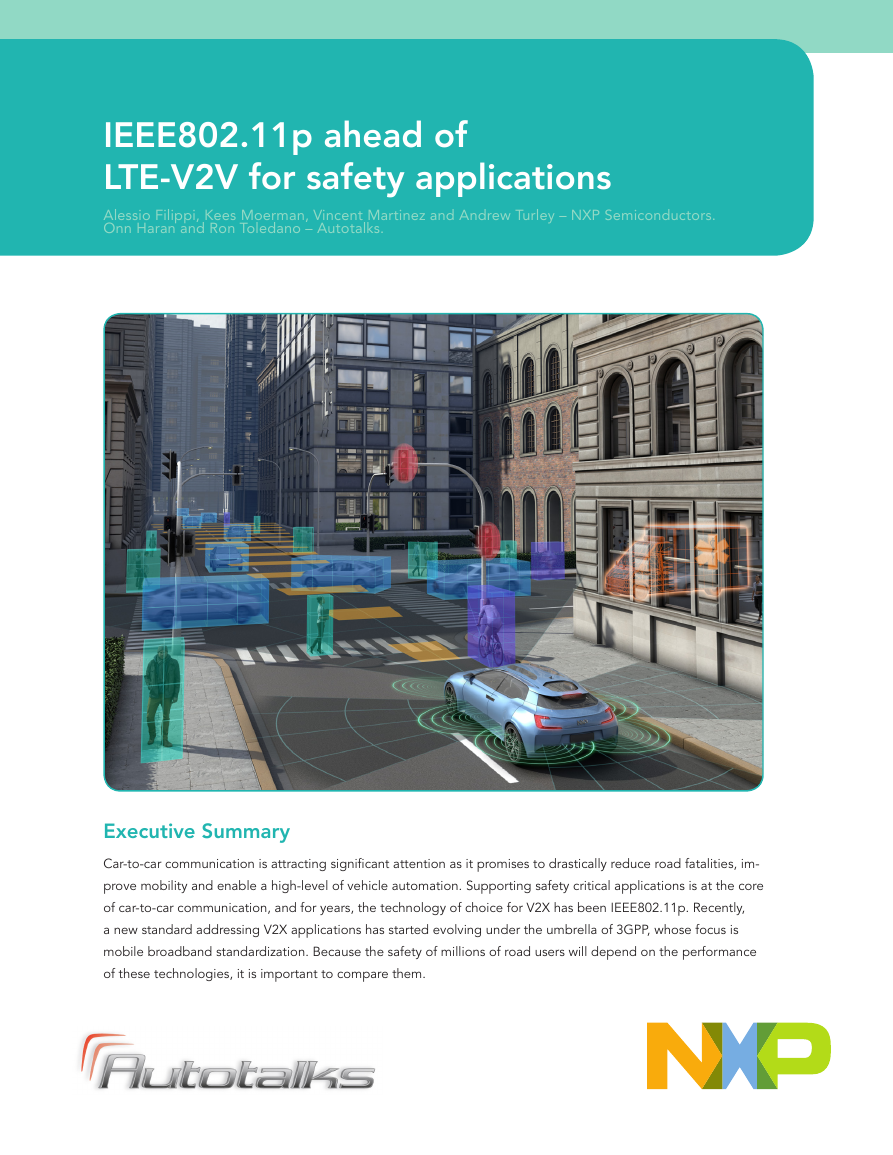
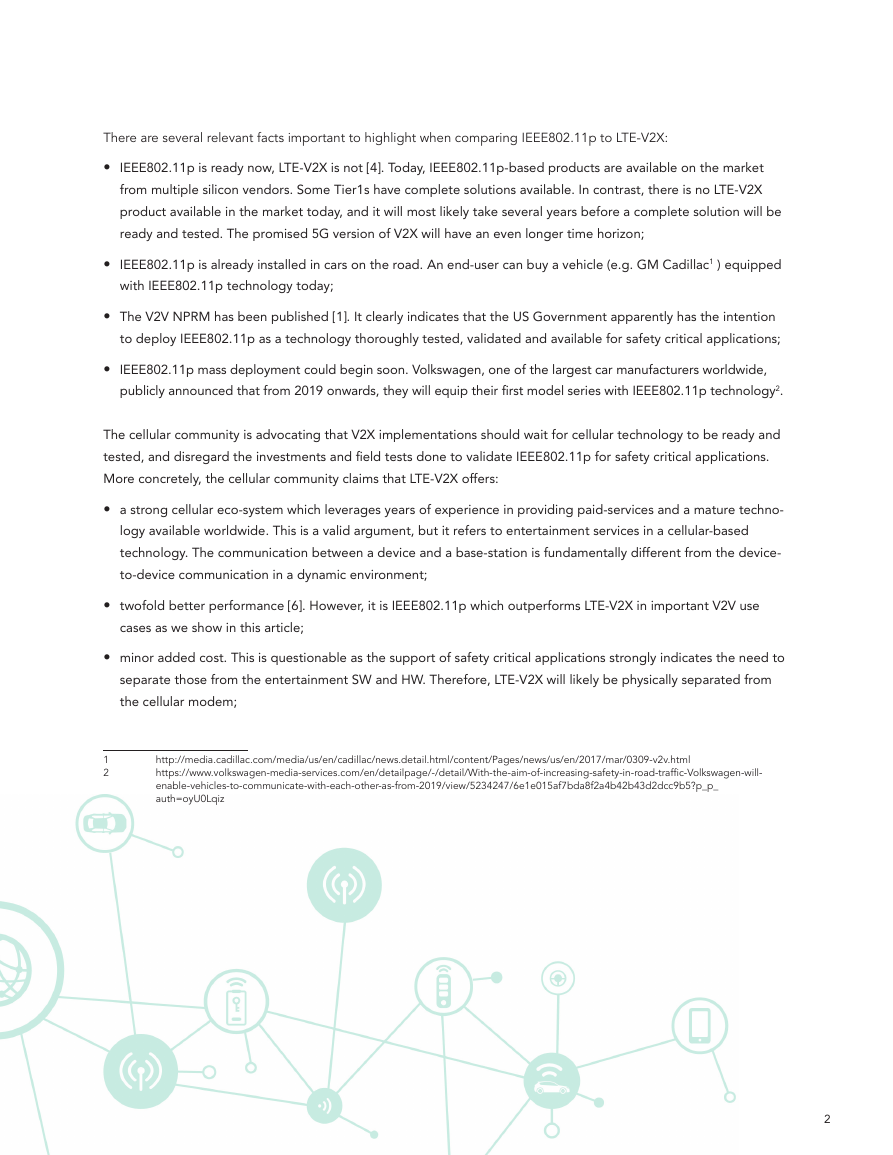
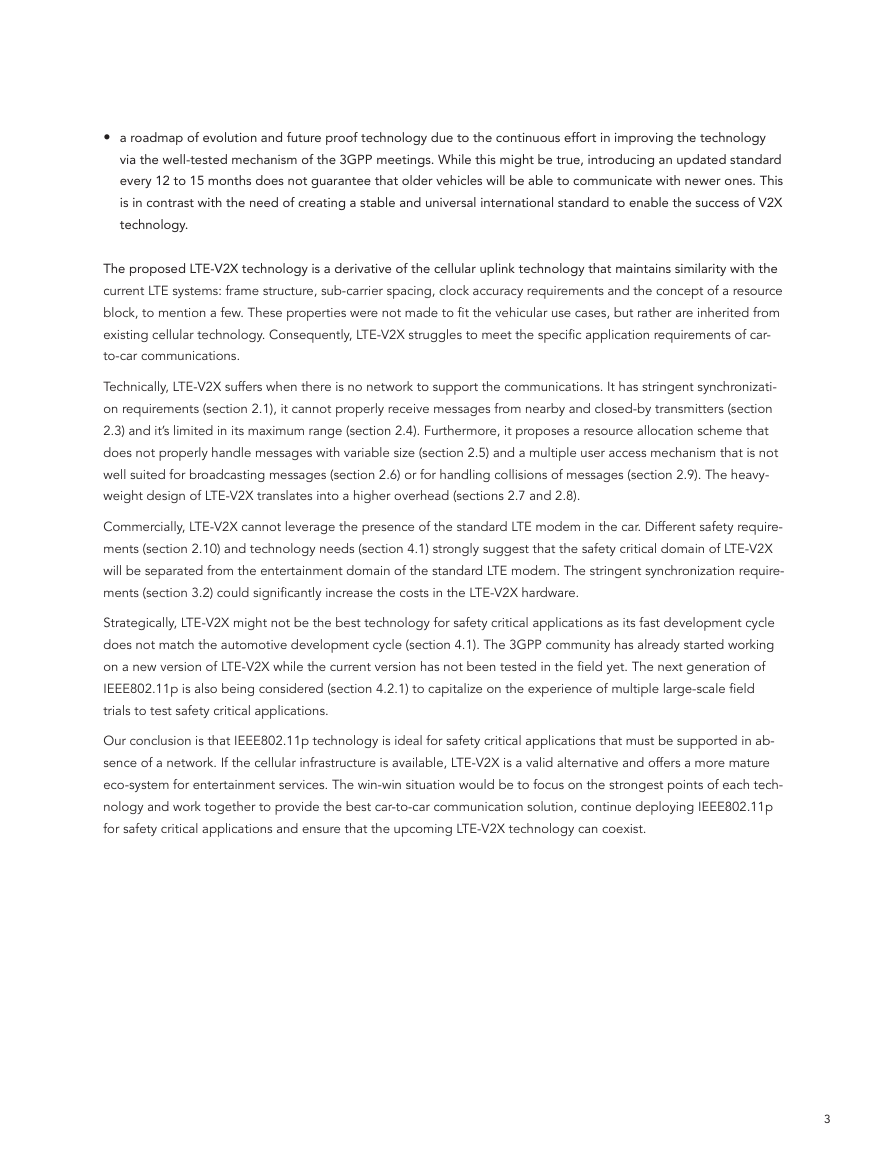
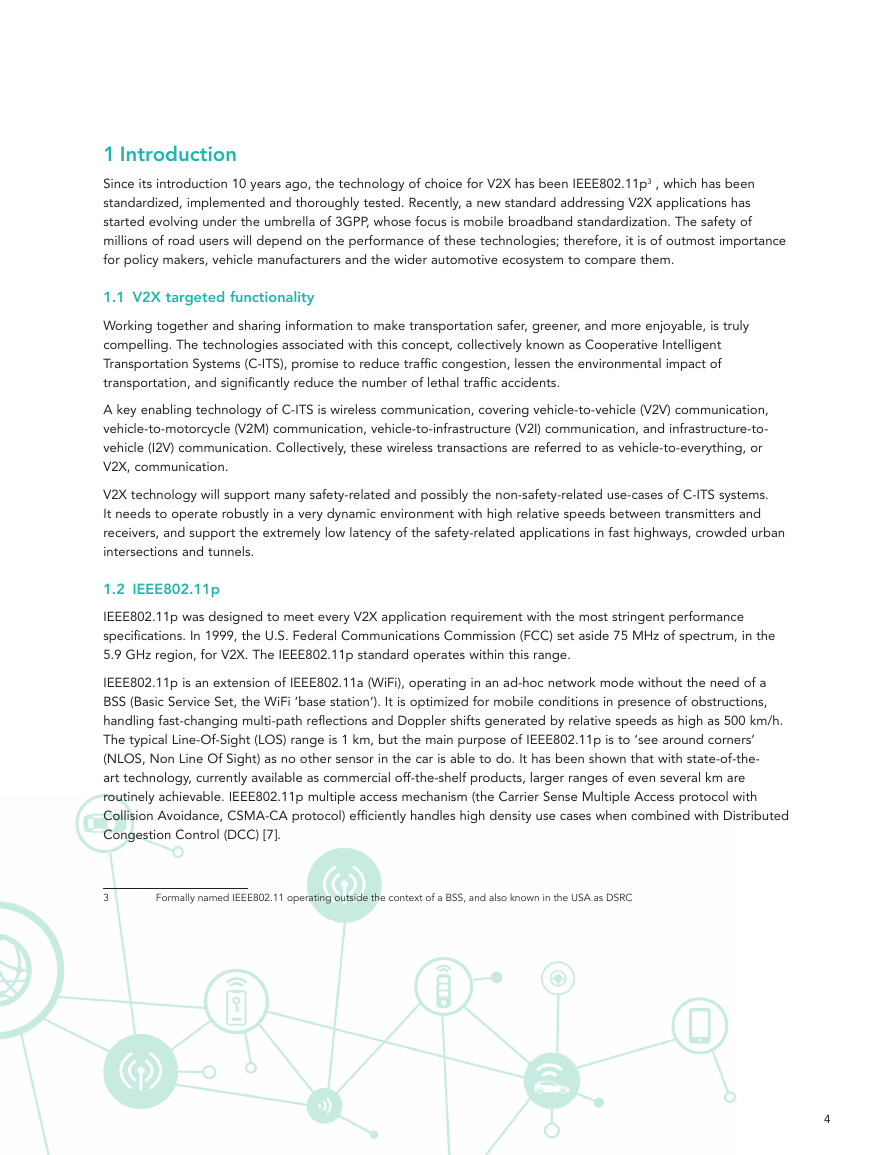
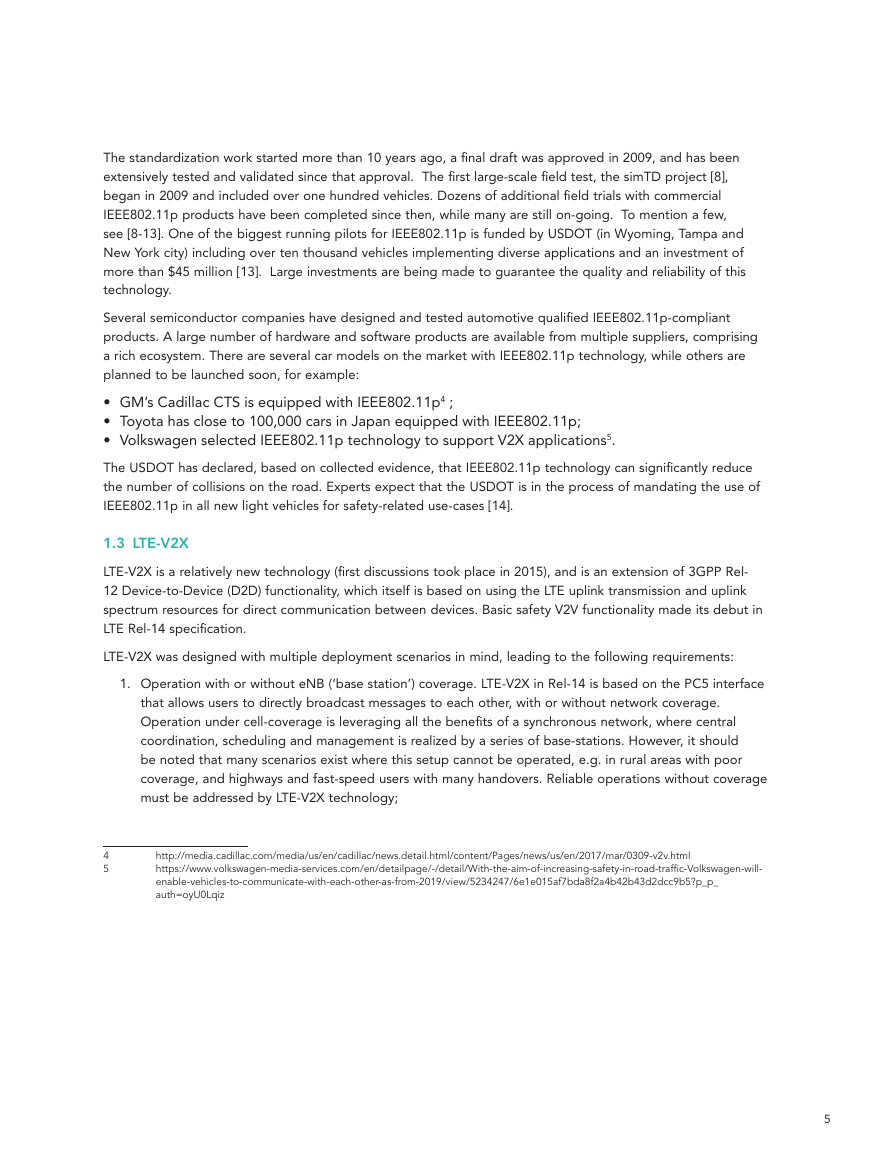
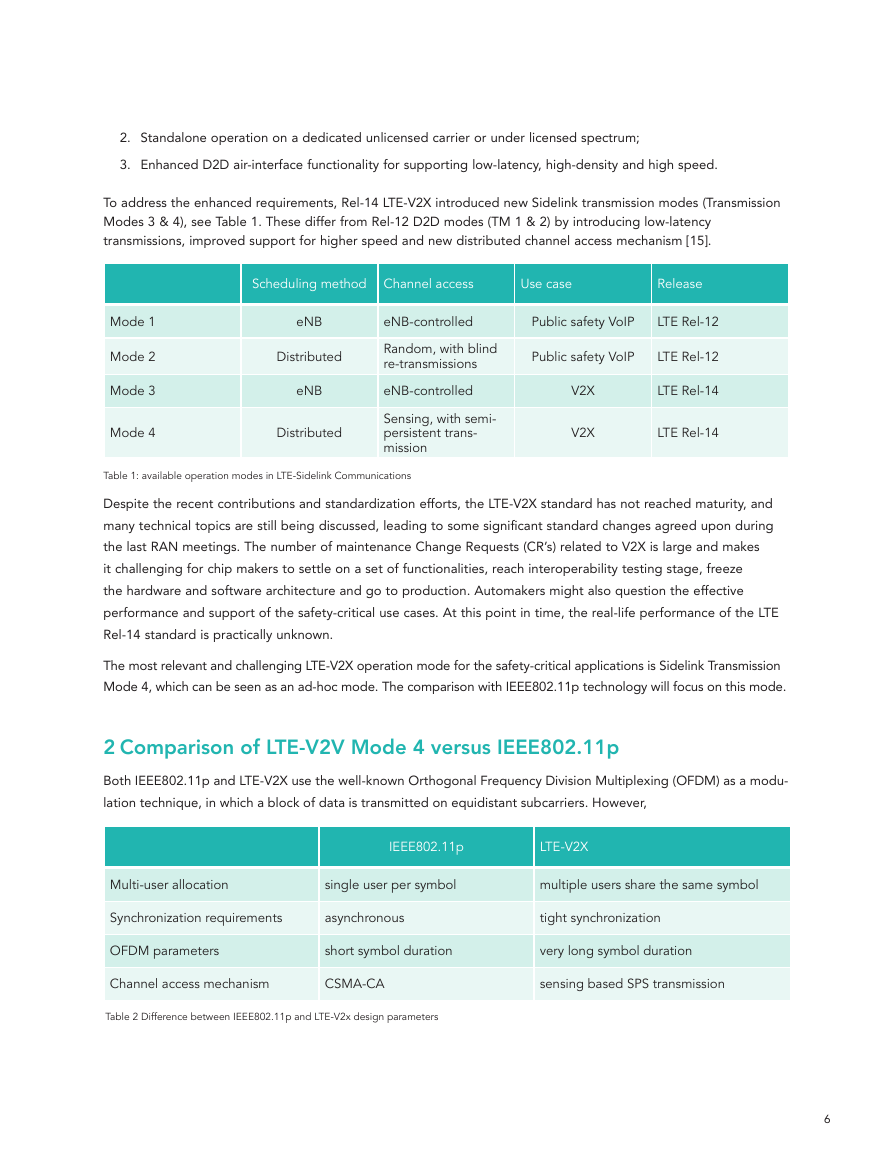
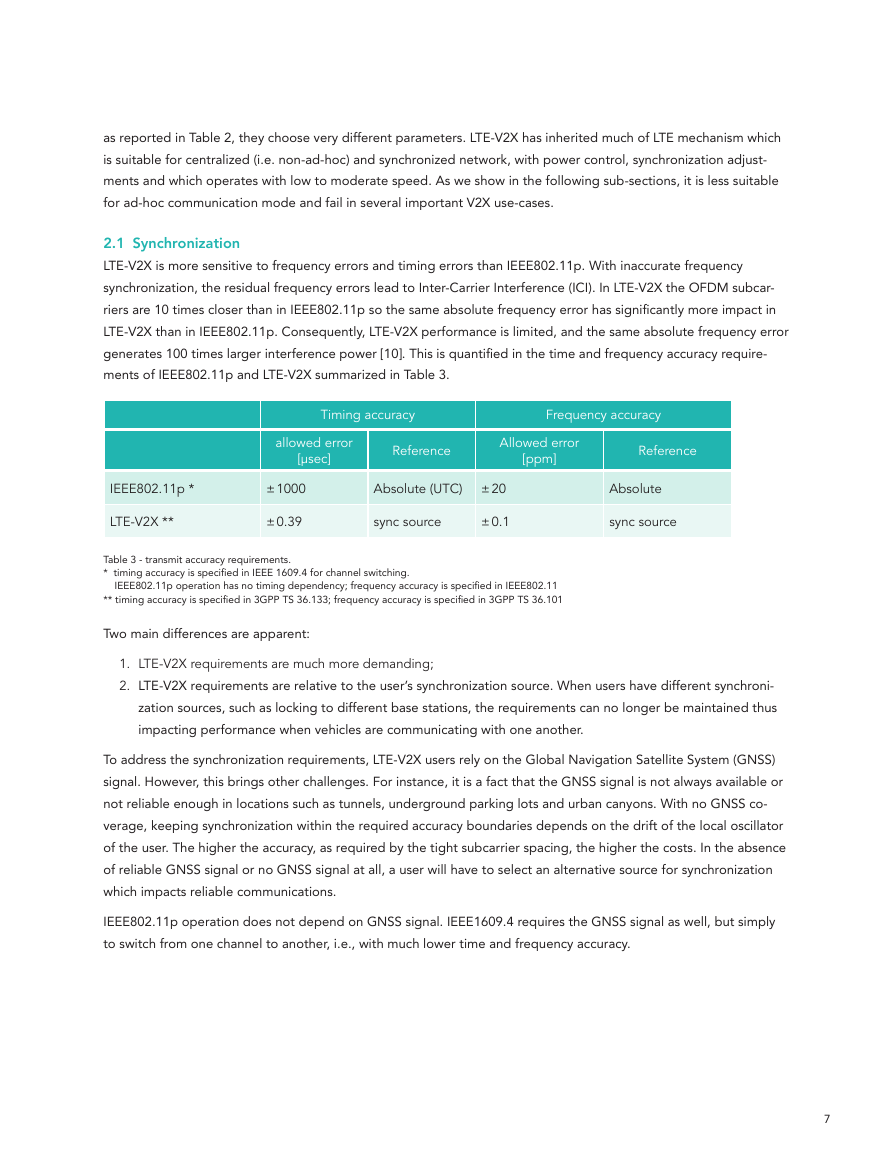
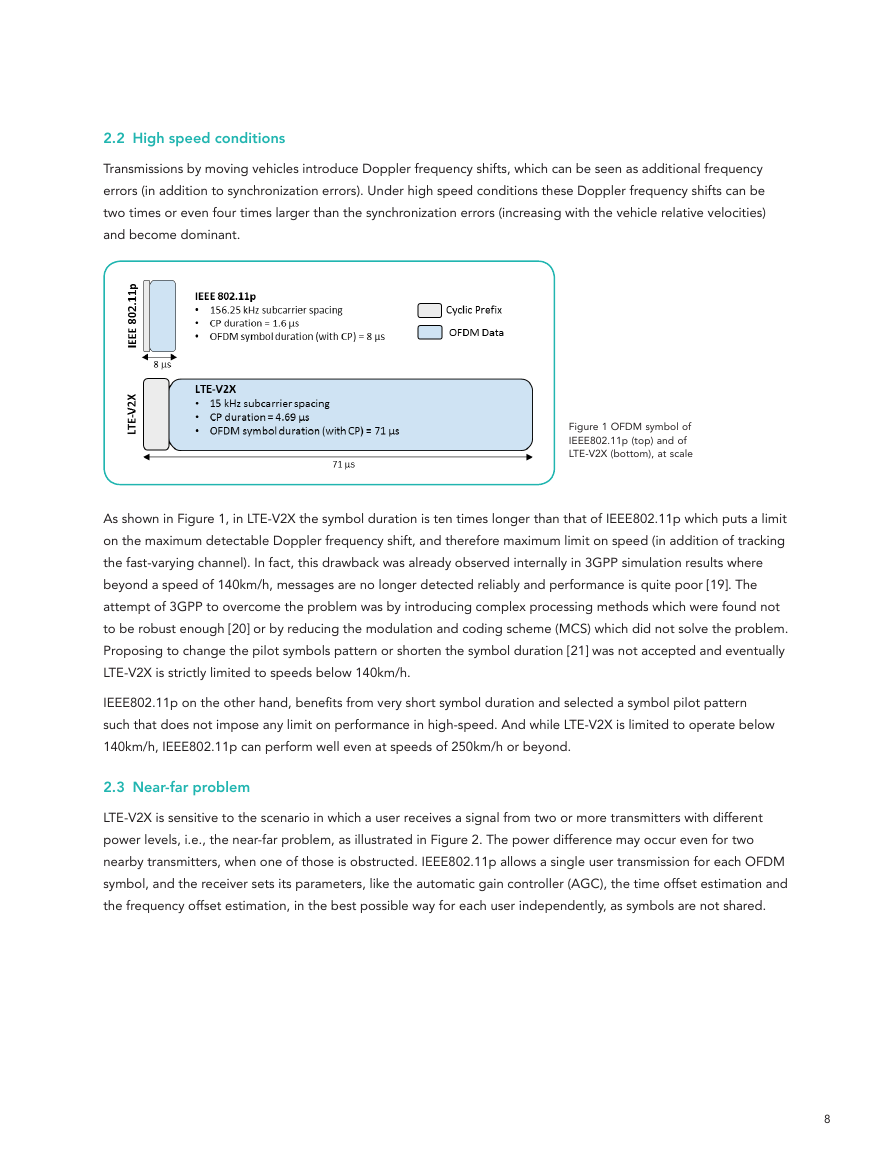








 2023年江西萍乡中考道德与法治真题及答案.doc
2023年江西萍乡中考道德与法治真题及答案.doc 2012年重庆南川中考生物真题及答案.doc
2012年重庆南川中考生物真题及答案.doc 2013年江西师范大学地理学综合及文艺理论基础考研真题.doc
2013年江西师范大学地理学综合及文艺理论基础考研真题.doc 2020年四川甘孜小升初语文真题及答案I卷.doc
2020年四川甘孜小升初语文真题及答案I卷.doc 2020年注册岩土工程师专业基础考试真题及答案.doc
2020年注册岩土工程师专业基础考试真题及答案.doc 2023-2024学年福建省厦门市九年级上学期数学月考试题及答案.doc
2023-2024学年福建省厦门市九年级上学期数学月考试题及答案.doc 2021-2022学年辽宁省沈阳市大东区九年级上学期语文期末试题及答案.doc
2021-2022学年辽宁省沈阳市大东区九年级上学期语文期末试题及答案.doc 2022-2023学年北京东城区初三第一学期物理期末试卷及答案.doc
2022-2023学年北京东城区初三第一学期物理期末试卷及答案.doc 2018上半年江西教师资格初中地理学科知识与教学能力真题及答案.doc
2018上半年江西教师资格初中地理学科知识与教学能力真题及答案.doc 2012年河北国家公务员申论考试真题及答案-省级.doc
2012年河北国家公务员申论考试真题及答案-省级.doc 2020-2021学年江苏省扬州市江都区邵樊片九年级上学期数学第一次质量检测试题及答案.doc
2020-2021学年江苏省扬州市江都区邵樊片九年级上学期数学第一次质量检测试题及答案.doc 2022下半年黑龙江教师资格证中学综合素质真题及答案.doc
2022下半年黑龙江教师资格证中学综合素质真题及答案.doc